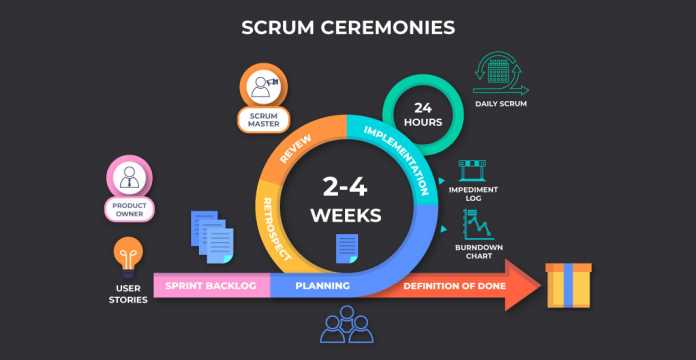
Scrum ceremonies are crucial times where their practice is orchestrated by the team, not necessarily for the latest Sprint. As an Agile software development system, Scrum lets teams produce goods that continue to grow. Scrum rituals ensure consistency during sprints.
What is Scrum Ceremonies?
Scrum has a fast set delivery period and flexible scale called sprints to satisfy quickly evolving production needs. A Scrum method is characterized by distinct principles and procedures from other agile systems, grouped into the three divisions of Tasks, Ceremonies (also Activities or Meetings), and Objects.
These scrum ceremonies serve and allow for several core / original values. Sometimes when teams give up those rituals, it’s because they no longer see the meaning of them, which means they may have discarded the costs as well.
Ceremonies in Scrum Cycle
Could Scrum Project have multiple release periods and will have several sprints for each update? There are a variety of repeated cycles of conferences to be held throughout the sprint loop before, inside, and after.
Scrum proposes three positions: squad, Scrum Master, and product owner; four ceremonies: sprint preparation meeting, Daily Scrum, sprint summary meeting, and historical sprint meeting; and three artifacts: product backlog, sprint backlog, and product increment.
Sprint Planning
The Sprint Planning ceremony aims to set up the whole Sprint team for success.
Participants are expected to:
- Measure Growth
- Coordinate with the Scrum Master
- Coordinate with the Product Owner
- Be part of Sprint planning, which takes place just before the start of the Sprint and usually lasts for about one to two hours.
Going into the ceremony, the Product Owner will have a summary of backlog things prioritized. The product owner communicates with the marketing team about each object or customer experience, and the community jointly calculates the commitment involved.
The marketing team will then make a sprint prediction, usually based on the team’s pace, showing how much project work can be done with the backlog.
Is there a Sprint Planning Ceremony at Kanban?
Yes, the Kanban teams still prepare, but they’re not on a set iteration timetable, unlike structured sprint preparation.
Daily Scrum (Daily Standup)
What Is a Daily Scrum Meeting?
The Daily Scrum is the possibility of the team getting together, establishing a schedule for the day’s work, and finding any obstacles.
What’s Its Purpose?
This scrum ceremony provides the organization with a regular chance to come together and discuss individual achievements towards the sprint target. For the product team, the Scrum Master can clear these obstacles, so they can concentrate on achieving the job described in Sprint Preparation.
The Everyday Scrum is more than just an overview of status; it is a pulse check that can highlight any challenges that impede the squad’s progress.
Any product team member can momentarily ask the following during the regular Scrum:
- What was it you were doing yesterday?
- What is it you are going to do today?
- Were there any hurdles in the way?
Any person in this scrum meeting must talk to one another and be attentive during the whole session. Also, product team members will find reasons for working together throughout the day, revolving around the Frequent Scrum statement.
Sprint Review
What Happens in a Sprint Review?
Sprint reviews concentrate on the product becoming made, precisely the increment of the product theoretically shippable generated during the Sprint. The Scrum Team encourages members to review what was done while the Sprint, through a sprint analysis. Based on the feedback, they change the Product Backlog as appropriate. The Software Owner is given a choice to launch all of the finished features.
Who Visits a Sprint Review?
The complete Scrum Squad attends the evaluation of the Sprint. Any partners, senior management, and other divisions impacted (e.g., communications, consumer support) are encouraged to participate and provide input. Scrum teams need to be welcoming as many individuals as the room allows — varied feedback is key to the development of fantastic goods.
How Long do Sprint Reviews Last?
Sprint reviews shall be limited to no longer than four hours.
The basic rule of thumb is to dedicate one hour per week of sprint length for sprint analysis. That ensures teams can study the sprint planning sprint for a two-week sprint and a one-month sprint of four hours.
Sprint Retrospective
The team is conducting the final scrum ceremony after sprint analysis but before the next Sprint: the sprint retrospective, also recognized as the Agile retrospective.
Just as the sprint analysis gives the team a moment to examine and refine the product they are creating, the sprint retrospective is a place for the team to focus on their operation.
Retrospectives are typically timeboxed at 30-45 minutes a week of the sprint period (depending on squad size). Still, some teams prefer to keep retrospectives in this block of time irrespective of their cadence.
The Scrum Master guarantees that members of the squad are available. The owner of the commodity may be present, but it is not necessary. No other partners need to participate, too. Indeed, individual employees might feel awkward examining their internal procedures in the eyes of outsiders.
A retrospective sprint has the aim of strengthening team processes. — Development Team member should have room for:
- Speak regarding the success of the partnerships, procedures, and tools that the team used to accomplish Sprint’s work
- Analyze what and what did not fit well
- Come up with a roadmap for the next Sprint that capitalizes on benefits and tackles drawbacks
Conclusion
With Scrum ceremonies, the team can optimize their effectiveness, encourage teamwork, preserve openness and, most importantly, review and adapt the way they go about a project so that they can enhance and practice with each other regularly.
To learn more about the different factors involved in the Scrum methodology, we would recommend pursuing popular Agile Certification Courses from an accredited training provider.
Some of the popular Agile Certification Courses that individuals and enterprise teams can take up are:














